October 8 – 9, 2015 —
We motored from Simi, Greece ten miles to Bozburun, Turkey along the southwest coast. This area of Turkey is known as the Turquoise Coast because of the color of the clear water. It is a tourist area, active with both cruisers and land based Europeans, Brits, and Russians. So far, as in Greece and Italy, we have seen very few Americans. We have, however, seen hundreds of American flags. Yes, HUNDREDS of American flags. Most of those boats have as their hailing port – Delaware! Go figure. Here is the answer: It is an easy tax shelter zone for boats from Turkey and Russia and they all fly a very small American flag along with their own flag as an improper courtesy flag. For any boat flying the flag of registry is necessary to be legal; in this case the US flag. We may not be among other Americans, but we certainly blend when we are on our boat. Not a bad thing. On the way into Turkey, we took down our Greek courtesy flag and put up the Turkish courtesy flag, a requirement in every country.
Our first task after arriving at the quay in Bozburun was to find and hire an Agent to check us in to Turkey. Using an Agent is now required, and although an unfortunate added expense probably a good idea. We started by talking with the owner at the restaurant across the quay from the boat. After a quick friendly hello they pointed out that our flag was wrong. 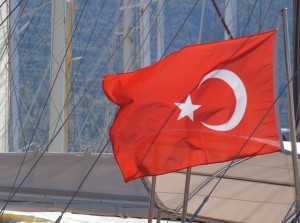 It looked Turkish to us and was marked as “Turkey” on the flag. Upon closer inspection it had the moon and star of the Turkish flag, but had them in an inner circle of the same color. Hmmm. They gave us directions to both a local Agent and the local boat chandlery to fix the flag. Our first stop was to pick up the new courtesy flag which, in fact, was slightly different. As it turns out, we had a mismarked Tunisia flag, almost identical to Turkey. The ironic part about this mix up is of the 50 or so countries we have sailed into over the years, we were being more careful to get the etiquette right for Turkey since we have heard that the Turkish Coast Guard pull boats over for flag infractions.
It looked Turkish to us and was marked as “Turkey” on the flag. Upon closer inspection it had the moon and star of the Turkish flag, but had them in an inner circle of the same color. Hmmm. They gave us directions to both a local Agent and the local boat chandlery to fix the flag. Our first stop was to pick up the new courtesy flag which, in fact, was slightly different. As it turns out, we had a mismarked Tunisia flag, almost identical to Turkey. The ironic part about this mix up is of the 50 or so countries we have sailed into over the years, we were being more careful to get the etiquette right for Turkey since we have heard that the Turkish Coast Guard pull boats over for flag infractions.
The Agent took our passports and boat documentation and headed off to the Port Police to start the check-in process, leaving us drinking tea in his office. Dirty and run-down can’t even begin to describe the office. As he left with all of our official documents we were both having serious doubts. Fifteen minutes later he was back and filling out more paperwork – Turkish VISA, Customs, Immigration, etc. After that we all headed off together to get the formal stamps. At each office our Agent, a real local, walked in, put the papers down in front of the official at the desk, picked up the official stamp, stamped all of the relevant pages, then handed the stamp back and we all left. The person behind the desk did nothing but watch. Within just a few minutes we were legal in Turkey. The cost of the required service was 480 TL (Turkish lira) – and worth every lira.
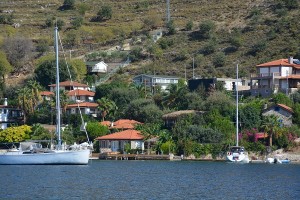 Bozburun is a small village supported through tourism. As we motored along the coastline in the harbour we couldn’t help notice the change from Greece.
Bozburun is a small village supported through tourism. As we motored along the coastline in the harbour we couldn’t help notice the change from Greece.
The area is much more wooded, largely with pines. The shore line looked like a mix between an Adirondack lake area with small docks, pine trees and traditional wooden homes, and an upscale 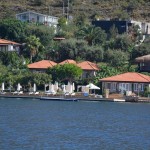 Florida waterway community with modern homes, red tile roofs and palm trees. Everything was nicely maintained and the docks were low lying docks down to the water–obviously an area of small tides and good storm protection. As part of Turkey’s Turquoise Coast and hot longer than most of Europe and the Med, it enjoys an extended season, almost to the first of November. Days here are still hot in the sun and the evenings are in the 60s, actually a break from the heat.
Florida waterway community with modern homes, red tile roofs and palm trees. Everything was nicely maintained and the docks were low lying docks down to the water–obviously an area of small tides and good storm protection. As part of Turkey’s Turquoise Coast and hot longer than most of Europe and the Med, it enjoys an extended season, almost to the first of November. Days here are still hot in the sun and the evenings are in the 60s, actually a break from the heat. 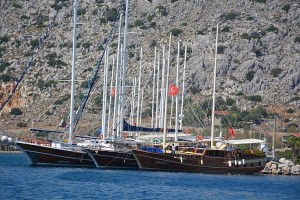 The area is well known for their Gulets, large wooden yachts.
The area is well known for their Gulets, large wooden yachts. 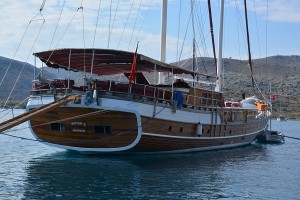 On our way to Bozburun for clearing in we motored past a number of these yachts in boat yards, marinas and on quays. The sailboats were, the largest, and oddest we have ever seen. They were all lined up beam to beam, probably over a hundred in this area alone for as much space as was available. They are 100 to 200 feet long, massive, beamy and all wood (some of the largest are steel). They looked like over grown, old fashioned sailing ships, but modern as anyone could imagine on the inside. We have never seen anything like it and the volume was staggering. We couldn’t help but wonder who owns these things and why…
On our way to Bozburun for clearing in we motored past a number of these yachts in boat yards, marinas and on quays. The sailboats were, the largest, and oddest we have ever seen. They were all lined up beam to beam, probably over a hundred in this area alone for as much space as was available. They are 100 to 200 feet long, massive, beamy and all wood (some of the largest are steel). They looked like over grown, old fashioned sailing ships, but modern as anyone could imagine on the inside. We have never seen anything like it and the volume was staggering. We couldn’t help but wonder who owns these things and why…
We thought Greece would be a major cultural change. It does have many changes from the US and other parts of Europe. The language and alphabet are different though the currency remains the same with the euro. Now, in Turkey, both the language and currency have changed. The currency is the Turkish lira (TL). At the moment the exchange rate is about 3TL to $1. It makes the math easy. The language, while we do not now understand it, has potential for us since the alphabet is western and the pronunciations are similar to English. The next few months will be a test. We are determined to learn the basic courtesy phrases.
Turkey in a pistachio-nut shell:
Turkey has a history back to 5,000 BC. Numerous sites from that period have been found and dated. First there was the Byzantine Empire dating from the 11th to the 15th century. Then the Ottoman Empire took over from 1453 to 1923. In 1832 after the Greek War of Independence, Turkey lost their islands in the Aegean to Greece, which explains why many of the islands, right up to the mainland of Turkey, are part of Greece. 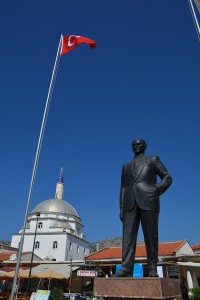 In 1912 Turkey lost Macedonia and part of Thrace in the Balkan Wars. Turkey entered World War I as a German ally. When the war ended, Turkey was broken up between the various victors. In 1922 Kamal Ataturk, a military hero and amateur linguist came to power as President and led the new Republic of Turkey until his death in 1938. He pushed Turkey into the 20th century and westernized the country. He made Turkey a secular state (separating church and state), by 1928 had changed the language to a western alphabet, made sweeping changes to the education system, and expanded women’s civil rights. To this day his photo hangs in every home and office.
In 1912 Turkey lost Macedonia and part of Thrace in the Balkan Wars. Turkey entered World War I as a German ally. When the war ended, Turkey was broken up between the various victors. In 1922 Kamal Ataturk, a military hero and amateur linguist came to power as President and led the new Republic of Turkey until his death in 1938. He pushed Turkey into the 20th century and westernized the country. He made Turkey a secular state (separating church and state), by 1928 had changed the language to a western alphabet, made sweeping changes to the education system, and expanded women’s civil rights. To this day his photo hangs in every home and office.
Since then, Turkey as continued to modernize and prosper. In 1980 only half of Turkey’s 42,000 villages had electricity. Now they all do.
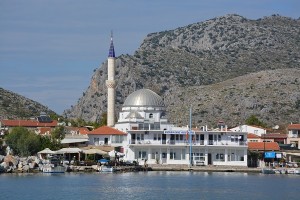 Turkey is 99% Muslim. Most villages have a Mosque and Minaret that announces the Call to Prayer five times each day. The first is at 6:20 am.
Turkey is 99% Muslim. Most villages have a Mosque and Minaret that announces the Call to Prayer five times each day. The first is at 6:20 am.
Turkey has major agriculture with fresh fruits and vegetables available throughout the year. Weekly open markets in most towns make fresh produce readily available.
In spite of what you hear about Turkish coffee, tea (called “cay”) is the national beverage. It is hot, strong and generally drunk with sugar. It is served in a small glass shaped like an hour glass on a saucer with a small spoon. Hospitality is important and tea is often offered in business or after a very brief conversation.  In every village men gather throughout the day at tables for four, to play a dominoes type game and drink tea.
In every village men gather throughout the day at tables for four, to play a dominoes type game and drink tea.
Currently Turkey is being pulled more into conflict with Syria and IS, due to its location and alliance with the U.S. It has also become the expressway for refugees fleeing Syria for the European Union and a safer existence.
